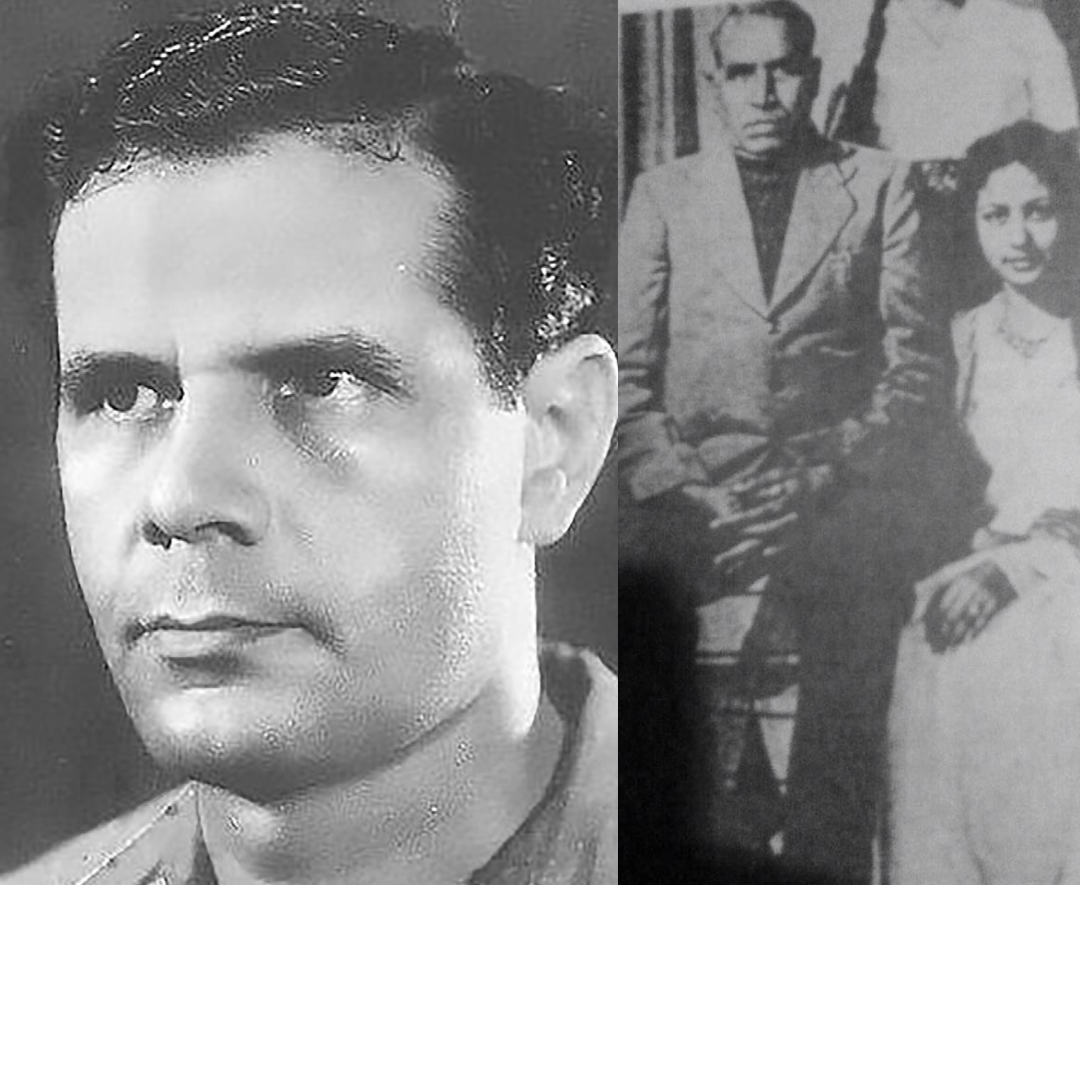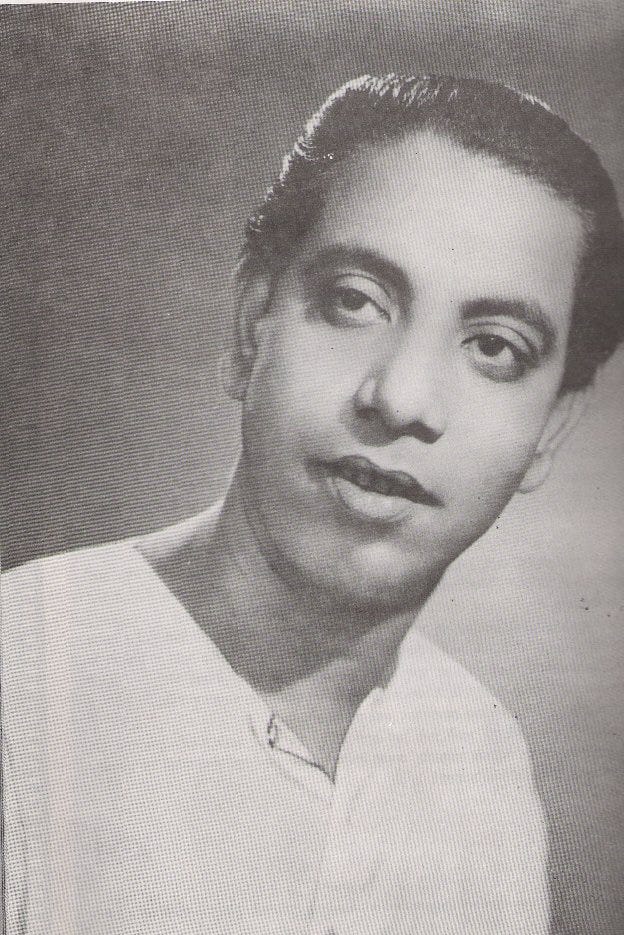Hidden Histories of Pakeezah

The film Pakeezah came out in 1972, but continues to live on. Each generation of people who love movies, music, dance, and art have discovered the film and found something beautiful and poetic. For me, as a Kathak dancer, the music and dance were an immediate pull. Whenever I heard the film songs or observed the dancer and choreographer, I had many questions and thoughts. Who are the dancers, where did the choreographers come from, who were the background dancers, who were the musicians who played such iconic music? Overwhelmed by the questions and confused about my own curiosity, I decided the best way to address the curiosity was to just follow it.
That journey led me to some amazing people, insights, more questions but above everything- even more love for the film and the artistic legacy it has left behind.
So welcome to my journey. I was glad that in the age of information overload where information is just a click away, I was able to experience the joy of discovering by following trails. Through this exhibition, I open up my process to you and hope you your time in this virtual space.
The exhibition is divided in three parts across 4 tabs and you can go to any part first you like by choosing the particular tab that interests you more. Go figure!
Unexpected-Intertwining Artistic Paths :
Considered one of the greatest magnum opuses of Indian Cinema, a study of the film warrants a deeper look at the people behind the film. Much has been said about the perfectionism and vision of Director- Producer Kamal Amrohi and his desire to make a ‘Taj Mahal’ for Meena Kumari in the form of this film, famously claiming that till Pakeezah is completed even death cannot take him away. I remain in awe of such an intense drive to bring one’s artistic vision to life, and I strongly believe that Amrohi’s film resembles a miniature painting, filled with so many minute details, all executed to perfection, that one has to keep coming back to the film, only to find some new detail or discovery every time.
However, my exploration here was not about Amrohi. It was directed intensely towards what I connected with intuitively- the music and dance in the film. The picturesque set design, the symbolism and the imagery of the film are all contained in a cloud of a musical score so exquisite, that it won’t be entirely wrong to claim that the music of Pakeezah has a major role in keeping the film alive till today.
It is at this point I can say that I let the artist in me take over the researcher in me. So overwhelmed by the pristine artistic sensibilities of the music and dance in this film, I wanted to know…I HAD to know, who WERE these people? Where did they come from? How could they create something so timeless? I was hungry for answers, even though I knew deep inside that there is no answer, there are only some facts and some stories we weave to interpret those facts. So here are some of my stories, some of my answers that helped me come closer to the works of art I was so inspired by.
In this tab, you will find some interesting facts, stories, trivia about the music and dance composers of the film, and most importantly the journeys they took. Their paths, become even more important when we consider how rapidly India was changing in 1930s, vis a vis patronage of arts, the emergence of the film industry in Bombay, the changes in the social make up of the dance community as well as the emergence of stage and cinema as avenues of art existing the in the public domain- where we see artists from very traditional set up adapting to these shifts.
You can take your time scrolling through the information. The + sign next to the headings indicate that there is more information awaiting when you click on that sign, that has been designed for you to choose and curate what all you want to take in in one visit of this space.
- Gauri Shanker – Choreographer
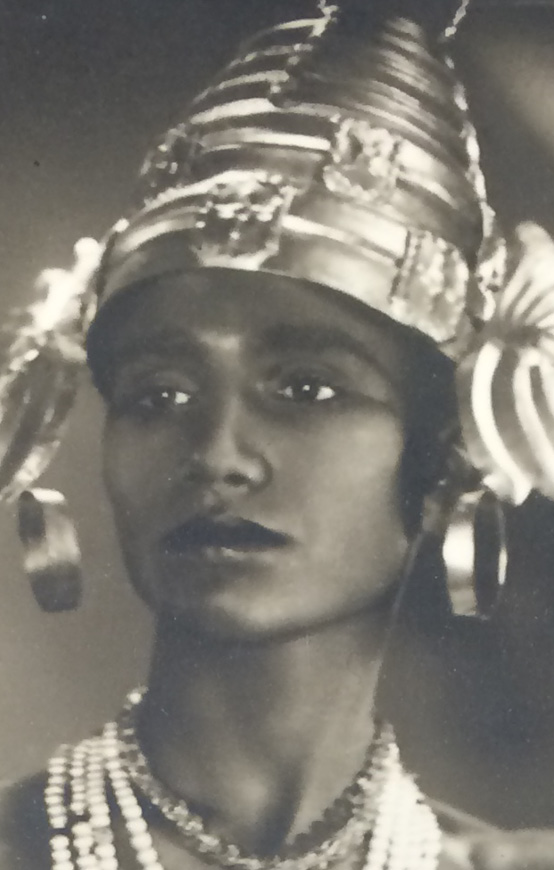
One of the first mainstream dance directors in Bombay Cinema to come from a Kathak background, Gauri Shanker migrated from Rajasthan to Bombay in search of work in early 1930s. A significant number of great artists such as Mubarak Begum, Allah Jilai Bai, Mame Khan, Bharat Vyas, Khemchand Prakash, Ila arun, claim lineage from Rajasthan, and specifically to the music and dance aesthetic of the region to flavour their art.
Belonging to the Jaipur Gharana of Kathak, Gauri Shankar got associated with Kathak dancer and choreographer Madame Menaka aka Leila Sokhey in the 1930s.
1930s was a very interesting time in the history of India. A nation at the cusp of independence, was undergoing fundamental changes in its social make up which reflected in the way the art and culture was shaping up too. One of the key changes was that women from non hereditary families taking up dance in the public domain, and one such woman was Madame Menaka, a key Kathak dancer and choreographer active in the 1930s and 1940s. She experimented with her dance vocabulary, and in alliance with the aesthetics of her time, created ballet productions with Hindu mythical themes, that found a keen audience overseas.

Years in Europe
As part of Madame Menka’s troupe, Gauri Shankar goes on a 2 year long tour to Europe, between 1936-1938. Their performance at the 1936 Olympic Dance Competition in Berlin was awarded the highest distinction by the judging committee, an event covered extensively in German Press. More details on this can be found here : https://menaka-archive.org/en?s=olympic#document=1417
Madame Menaka’s aesthetic differed quite a bit from traditional Kathak and incorporated very Oriental costumes, music, while combining that with her training in Kathak, but at the same time expanding the dance vocabulary liberally and creating her unique ‘ballet dance drama’ aesthetic.
This video from the German film Tiger of Hastinapur helps us understand the art, its aesthetic and who it was trying to speak to.
Watch out for the young Gauri Shanker who makes his entry in the frame at 1:51. This is the same person who choreographed ‘Chalte Chalte’ in Pakeezah, a connection I would have never imagined!
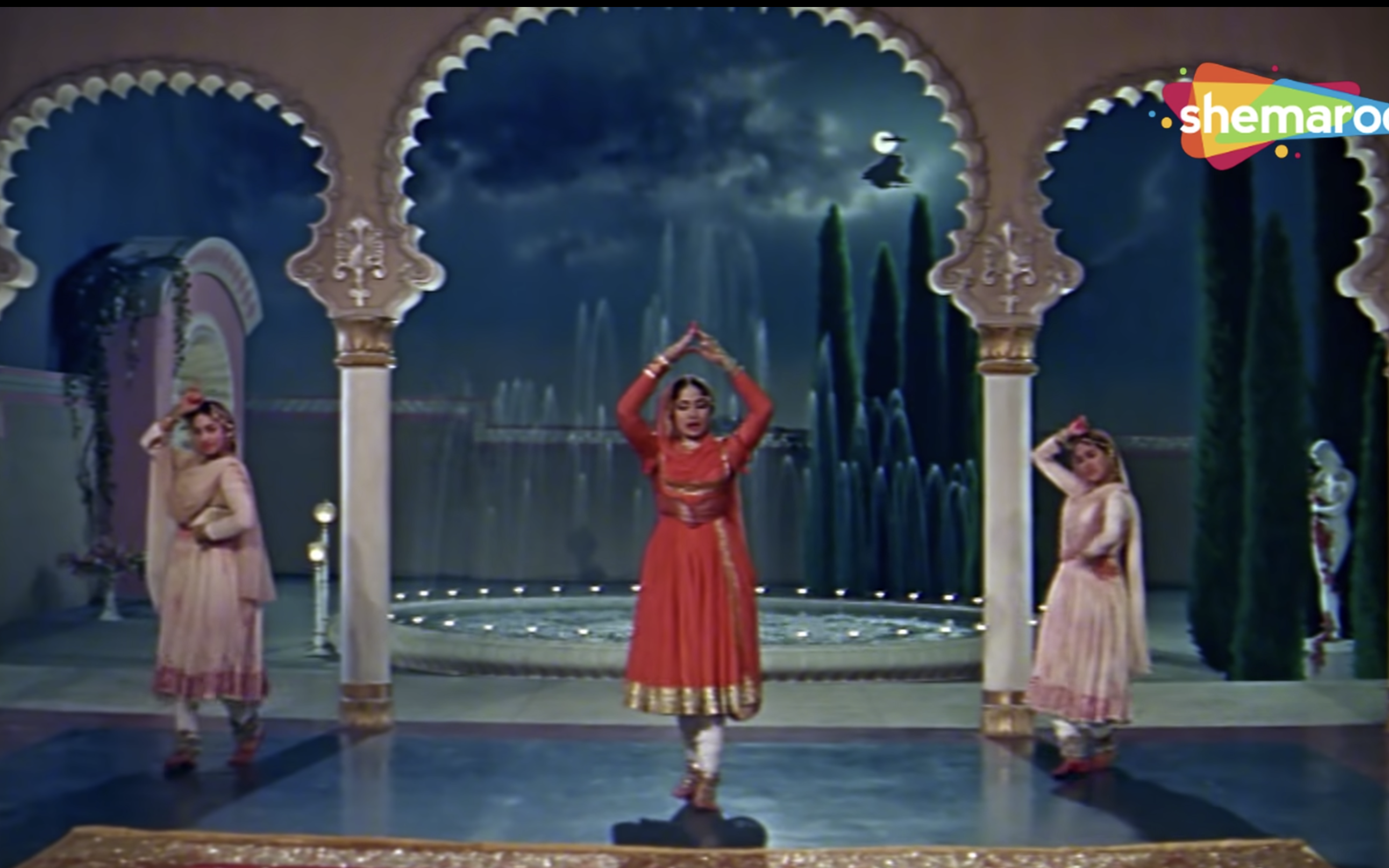
What I find most interesting about the trajectory of Gauri Shanker is that despite coming from a traditional hereditary dance community, his work in Europe, his participation in dance dramas and ballets designed for a western european audience, as well as belonging to an evolving ecosystem of artists- perhaps gave him a sense of composition, framing, group formations and a working knowledge of dancing for the camera, as opposed to dancing for the stage. Most traditional kathak dance training and practise, especially in the 1930s was a solo performance oriented practise, designed for frontal viewing and performing, as opposed to camera work that began evolving around 1950s. But his work in dance dramas as well as the German film, would have influenced his sense of choreography, as well as given him the experience of performing his dance completely outside his context.
Have a look at some of these interesting images that convey a sense of the variety of work he did before working on Pakeezah : (all 3 images below courtesy menaka-archive.org)

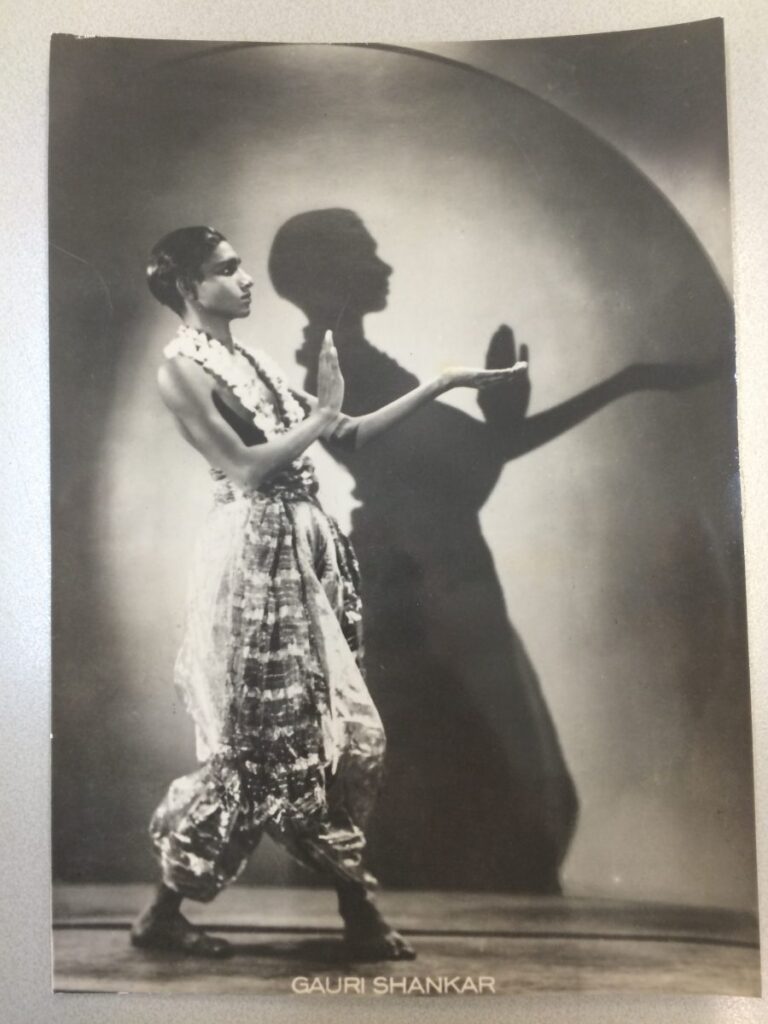

Active Years in Bombay Cinema
It is unclear the number of times he went to Europe, it is likely he might have gone before 1936 as well. However it is certainly clear that he choreographed in many films in the 1930s and 1940s, however it is hard to find 100% verifiable credits on Imdb. Many films where I hear he choreographed do not have complete credit sequences in their films in the versions available in the public domain. He also taught Kathak to many Bollywood actresses of that time, such as (L-R) : Geeta Bali, Anjana Mumtaz, Kumud Chhugani, Meena Kumari, Sandhya Shantaram





2. Lacchu Maharaj: Choreographer for ‘Thade Rahio’
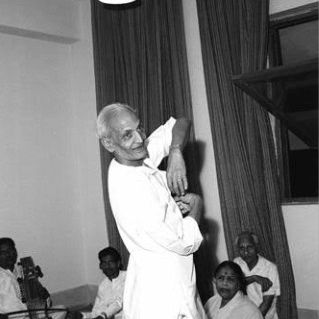
Lacchu Maharaj(1901-1978) was a Kathak exponent of the Kalka Bindadin- Lucknow Gharana of Kathak. Originally hailing from Lucknow and also having been associated with the court of Nawab of Rampur, he moved to Bombay and began his career as a dance director and dance teacher.
There is very little archival material on him and in fact most other people who are part of my virtual exhibition. He had choreographed for some iconic films such as : Mughal-E-Azam (1960), Mahal (1949), Benazir (1964) among others. Lacchu Maharaj was also a poet, having composed many beautiful literary compositions such as Kavitt. Here is a rare video of the master himself showing abhinaya :
In the course of my research I met a lot of people, from the film industry and otherwise, who spoke about Lacchu Maharaj as the master of ‘abhinaya’. Almost everyone, including background dancers in the film industry remembered him as someone who could write, emote and express the hardest of human emotions with a soft grace.
Generally, when we look at poetry written by Kathak dancers, a large body of it is centred around the love of Radha and Krishna, the leelas of Krishna etc due to a strong influence of Vaishnava Bhakti in Kathak’s development. However, I was very delighted to find this poetry called ‘sehra’ written by Lacchu Maharaj. In this video, narrated by his nephew Lt.Padma Vibhushan Pt. Birju Maharaj, he speaks about Lacchu Maharaj’s preference to write in Urdu. In the beginning of the video, Birju Maharaj also elaborates an instance from the song ‘Pyar Kiya to Darna Kya’, an example of his command over abhinaya and interpreting literature in a variety of ways to convey the essence of the meaning.
His students include : Kumkum Dhar, Padma Sharma and he was also awarded the Sangeet Natak Akademi Award in 1957.
It is interesting to note the legacy of the Lucknow Gharana in Bombay Cinema, as Lacchu Maharaj’s nephew Lt. Birju Maharaj went on to choreograph classics such as (L-R)Bajirao Mastani, Devdas, Shatranj ke Khiladi, among others.
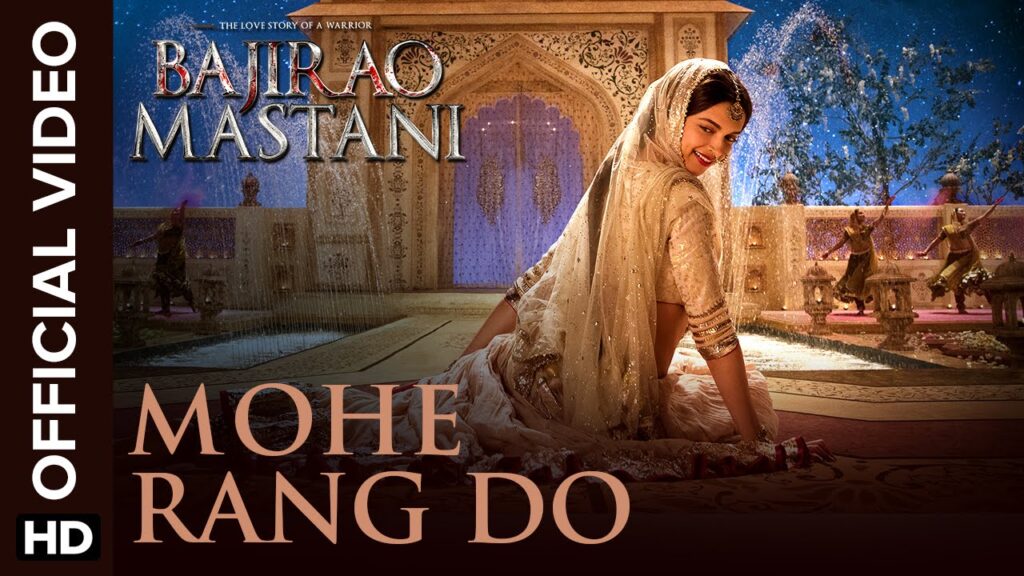
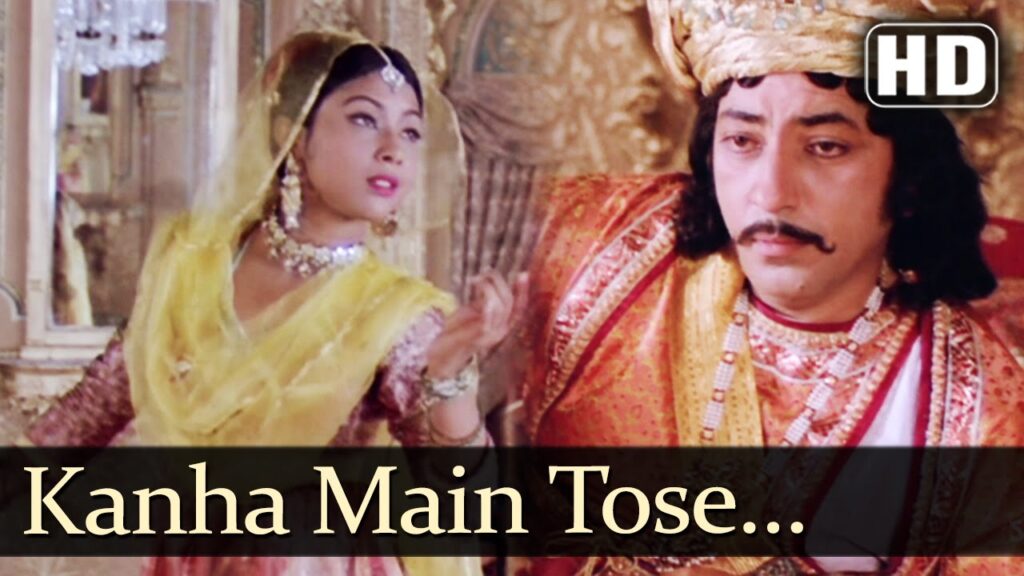

3. Ghulam Mohammed- Music Composer
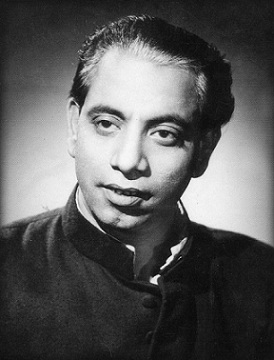
Born in 1903 in Bikaner to family of cattle breeders and farmers who also served the Maharaja Ganga Singh of Bikaner, Ghulam Mohammed started learning Tabla from his father Nabi Baksh. From a very young age he started performing in Urdu Theatre, starting with the New Albert Theatrical Company in Lahore.
- Inhi Logon Ne Le Lina Dupatta Mera
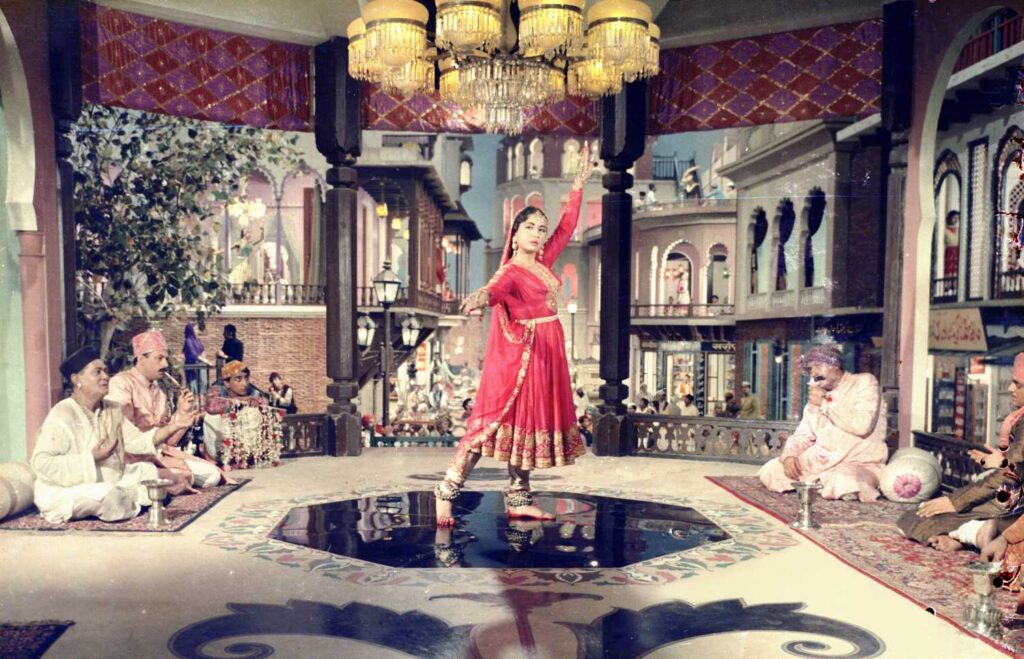
Singer : Lata Mangeshkar
Music Composer : Gulam Mohammed
Dance Director : B.Hiralal, Gauri Shanker
Lyrics : Majrooh Sultanpuri
The set

But there is one very interesting person in the frame. Someone who we would have ignored as just another extra in the film. Lets get to him now :
Who is this person?
I would have most likely dismissed this person as another extra. Have a closer look at him :
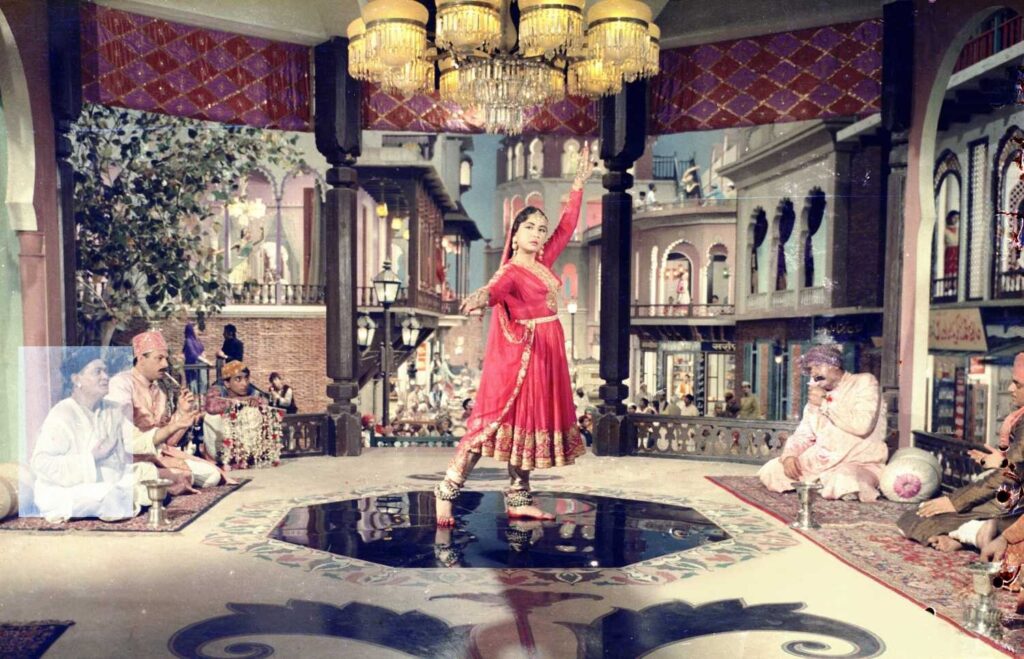

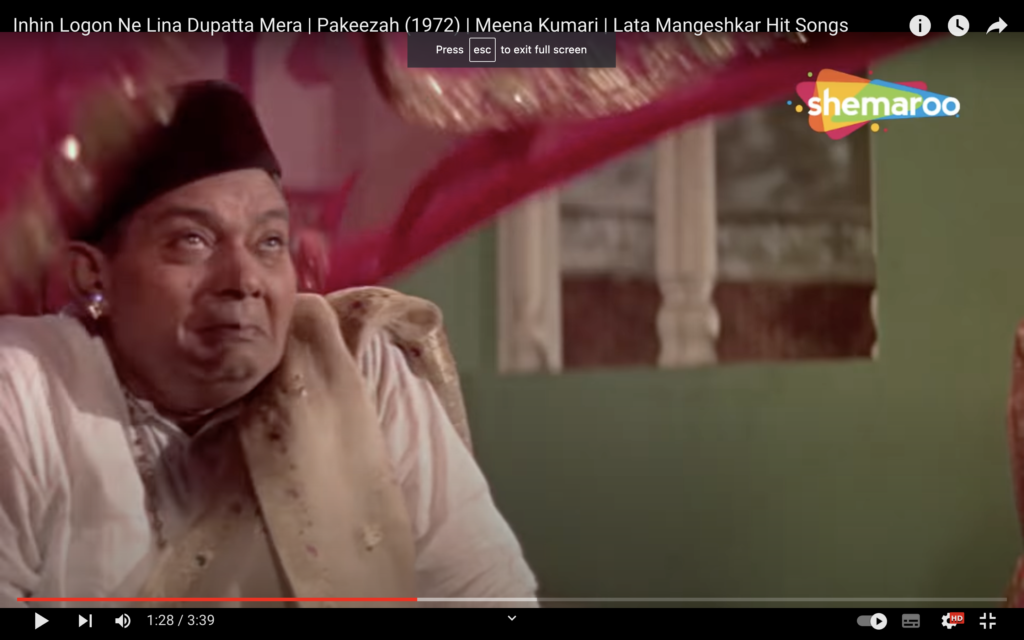
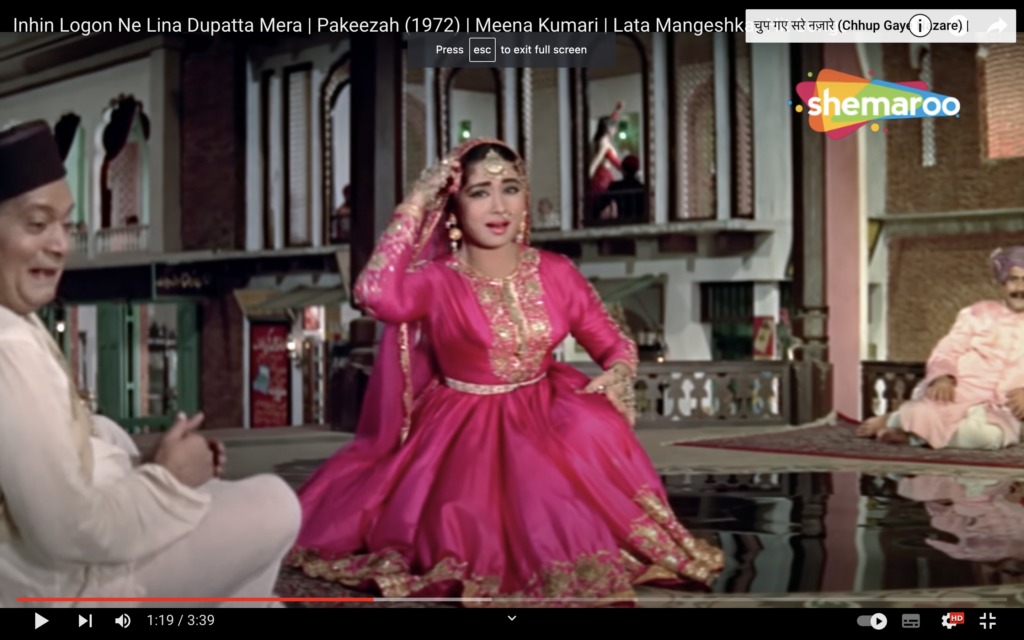
With his endearing theatrical expressions, he plays the ‘bajajwa’ that Sahibjaan first playfully accuses. Little did I know, that he was the father in law of the music composer Ghulam Mohammed!
His name is Nasir Ahmed, and along with his brothers… he founded the Jodhpur Bikaner Theatrical Company in the late 19th century!? confirm years.
Coming back to the point about the background dancers, this also became an inspiration in the set created by Sanjay Leela Bhansali for Devdas’s (2002) song ‘Kahe Chhed Mohe’, picturised on Madhuri Dixit

In my interview with yesteryear dancer-actress Anjana Mumtaz, to my utter surprise she recalled that she was a disciple of Pt. Gauri Shanker, one of the choreographers of Pakeezah, and thus she spent many weeks and months on the sets of Pakeezah as young girl, watching the shooting rehearsals. She remembered the dancing extras from the movie, the way Kamal Amrohi would brief Meena Kumari, the ‘mahaul’ of the set, and many more small small details.
Regarding the multiple dancers at the back in inhi logon ne, Anjana said something interesting :

‘Pakeezah gave a break to many dance masters into the industry. Background dancers ko taiyyar karne ke liye bhi Amrohi sahab was very particular that they should perform coordinated steps, and it should be a proper performance, not something random. There was one separate dance director for each of those background kotha girls, and many dance directors found a path to forge their career in Bollywood from the training they got on those sets’
When we read the history of dance and dancers in Bombay Cinema , these instances become important in figuring out the social make up of the industry, what are the channels and routes people are using to create their careers, and what all personal/regional histories are colliding in one place. Apart from giving a window into Amrohi’s work ethic and commitment to what he was doing, it also was an exciting time for me to break down the way the exchange of learning happens in the film industry. Where people pick up skills and learn on the job, and the film set becomes a training ground to learn. This means that even a skill of classical dance, which usually takes multiple years to master and the student first learns and then enters the profession, here dancers enter the film set semi trained and learn elements of classical dance on the job from each other.
A very good example of this is choreographer PL Raj learning Kathak from Rani, a Kathak dancer from Kolkata who worked as a dance assistant and extra dancer in films. PL Raj on the other hand, went on to become an established dance master working with Helen, Shammi Kapoor, Saira Banu, etc and created Bollywood’s memorable cabarets.
Another exciting connection that emerges here is that between Ganesh Acharya and Gauri Shanker. While Ganesh Acharya is known for foot tapping dances like Oo Antava, ‘What Jhumka’ (2023), Chikni Chameli, his father Krishna Kumar Gopi was an assistant to Dayal Shanker, Gauri Shanker’s brother and film dance master. It is not yet clear on the extent of Ganesh Acharya’s Kathak training to me yet. However, this study of eco systems, the crossing of people’s paths as well as the relationship between masters and assistants provides another route to pursue research, apart from studying Gharana based lineages.

Speaking of the history of the song, have a look at the earlier footage of the song ‘inhi logon ne’, when the film was being shot in black and white. This version was choreographed by B.Hiralal.
The song Inhi Logon Ne was first sung by Shamshad Begum in the movie Himmat (1941)
2. Thade Rahio O Baanke Yaar
What is common b/w Meena Kumari & Ali Sethi?
Pay attention to the verse with which Sahibjaan opens her mujra (0:10 to 0:55)
चाँदनी रात बड़ी देर के बा'द आई है लब पे इक बात बड़ी देर के बा'द आई है झूम कर आज ये शब-रंग लटें बिखरा दे देख बरसात बड़ी देर के बा'द आई है दिल-ए-मजरूह की उजड़ी हुई ख़ामोशी से बू-ए-नग़्मात बड़ी देर के बा'द आई है आज की रात वो आए हैं बड़ी देर के बा'द आज की रात बड़ी देर के बा'द आई है आह तस्कीन भी अब 'सैफ़' शब-ए-हिज्राँ में अक्सर औक़ात बड़ी देर के बा'द आई है The same verse was adapted by popular singer Ali Sethi recently into a song :
Written by Saiffudin Saif, the original verse has been adapted by many singers in different ways.
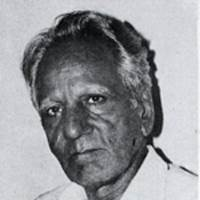
Saifuddin Saif (1922-1993) Pakistani poet, lyricist
On one hand there is the hidden history of the film, and on the other is the history of this song itself. A traditional dadra from Banaras, sung by siddheshwari devi, shobha gurtu among others, thade rahio o baanke shyam, became thade rahio o banke yaar on the screen. songHave a look at these renditions :

Abhinaya :
I wrote about the ability of Lacchu Maharaj to weave layers of abhinaya through his interpretive movements. While for other songs in the film, the choreographer was Pt. Gauri Shanker, for this song Pt. Lacchu Maharaj was brought in for the unique character of the Lucknow Gharana of Kathak. choreographer.
The particular line here is : Main to dheere se kholungi dwar re , meaning ‘I will slowly open the door (for my lover)’.
But the movement given to Meena Kumari is to slowly reveal her face to the lover, by lifting her ghunghat(veil).
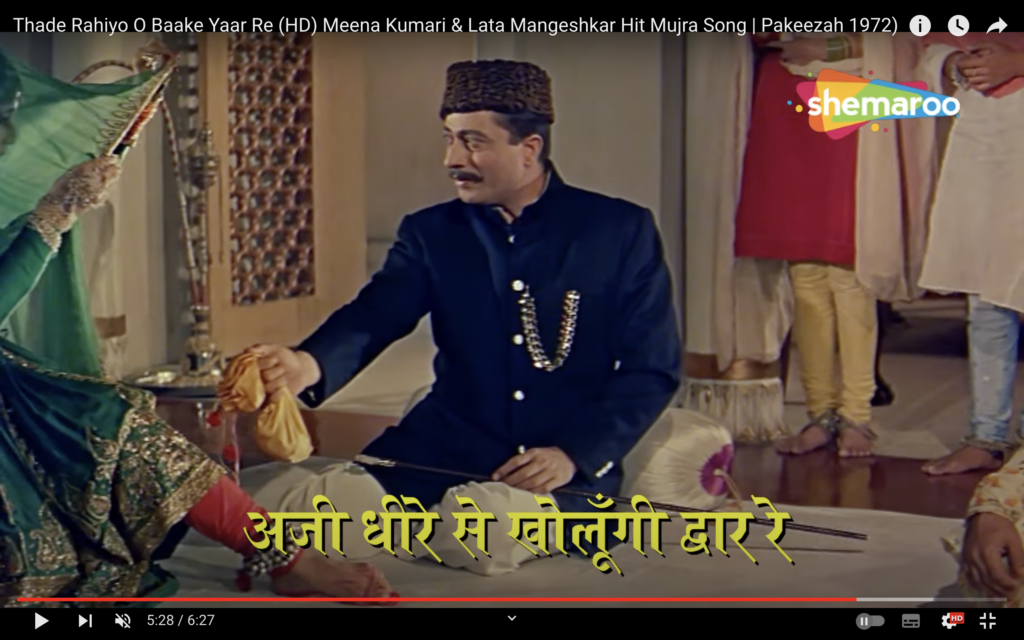
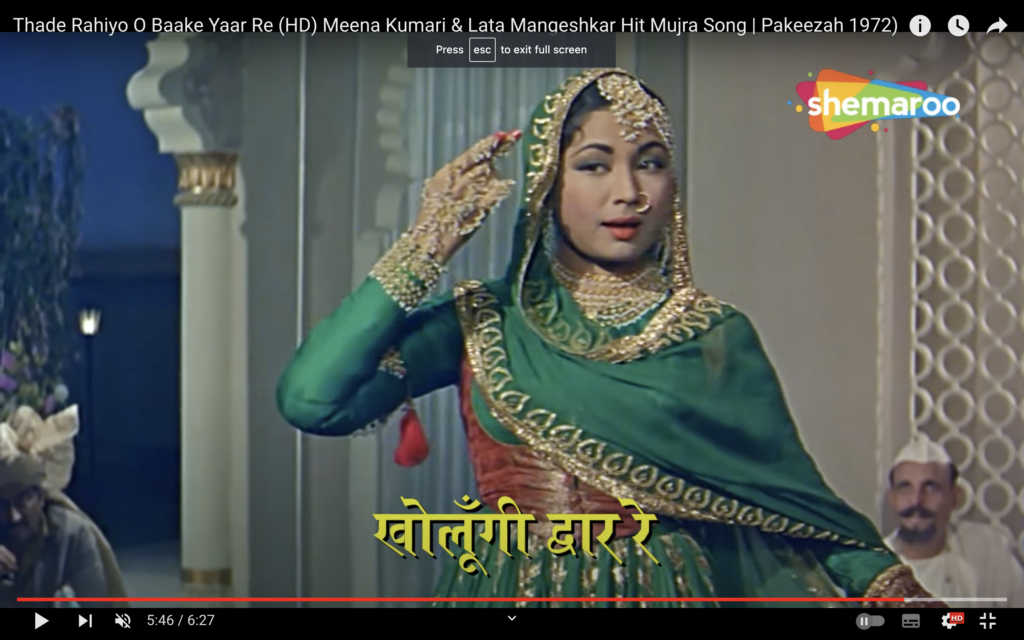
The best is not here yet. It comes when there is a striking close up of Meena Kumari, and only a string of Sitar in the background. The final time she enacts this line, she slowly reveals her eyes, signalling that the interpretation of the door has gone deeper, from the face, to the eyes.
This relationship with text is very special, and has dwindled both in the classical dance world as well as film world. Where the approach to choreography is neither a literal depiction, nor completely abstract, but catches the essence of the meaning, and builds images and symbols that convey that essence, instead of the literal action.

Kathak- Dance or community or both?
While Kathak is commonly understood as a dance form, it is historically also traced as a community of artists comprising of musicians, percussionists and dancers, who often put ‘Kathak’ as their surname. This I was familiar with. I had read Margaret Walker’s extensive research on this.
What I was not prepared for was this :
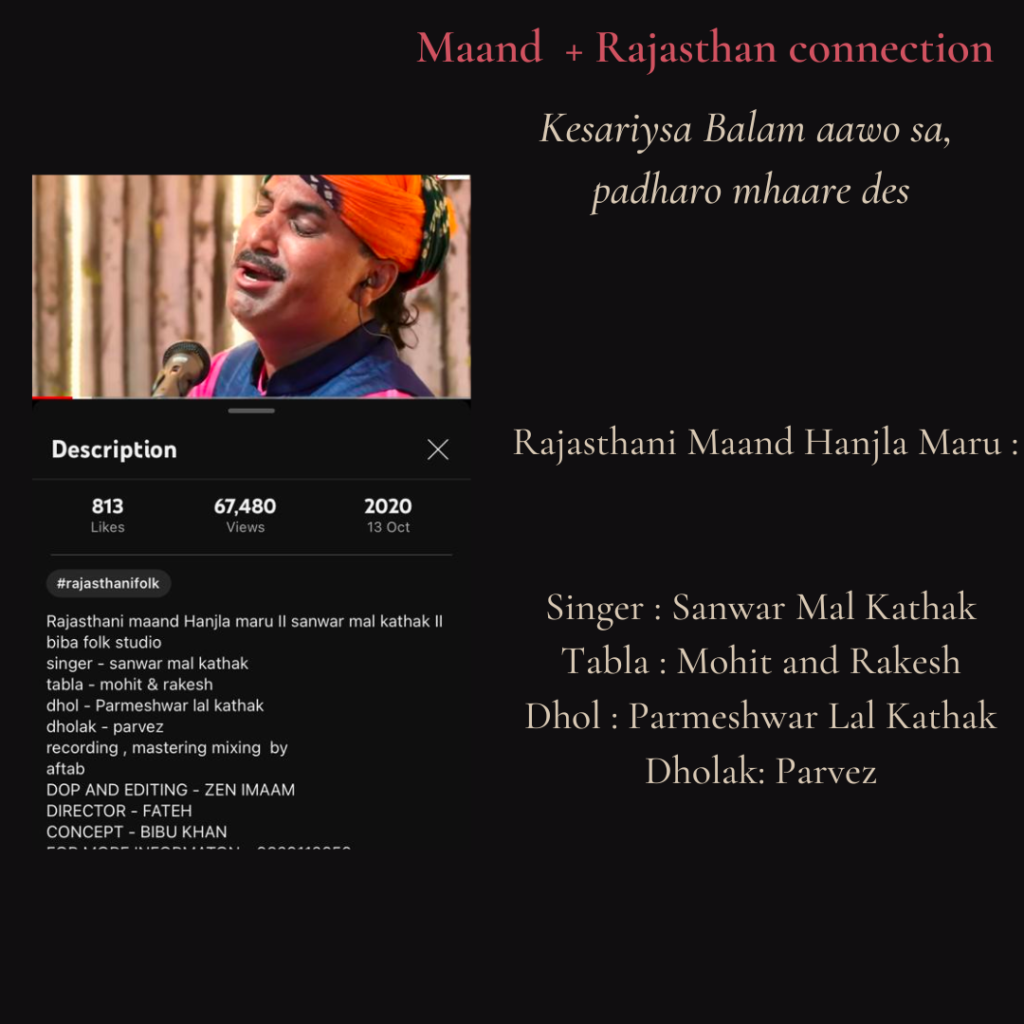
That there are Mand singers who also belong to the community of ‘Kathak’. This screenshot is taken from a youtube video of a Maand singer, and when I went through the credits to see the artist names, I found that there surname is ‘Kathak’, signalling a connection with kathak community of artists who are not just dancers but also singers and percussionists.
Maand is a singing tradition from Rajasthan, and the song Thade Rahio is also influenced from the style of singing of Maand, the musical notes, the languid musicality and the style of voice projection. Perhaps the most famous maand we have all heard is ‘kesariya balam padharo mhare des’. I had never connected Maand, a singing style with Kathak, and this connection definitely warrants a deeper exploration.
3. Chalte Chalte Yunhi Koi Mil Gaya Tha

You might have noticed by now that the lyricists for the songs are different. Kaifi Azmi, Kaif Bhoplai and Majrooh Sultanpuri were the 3 lyricists of the film. However, it is to the credit of all 3 lyricists as well as Kamal Amrohi, that the songs though written by 3 different people, fit seamlessly into the story, and also convey the impression of being aligned with the larger story of the film as it progresses.
(L-R) Kaifi Azmi, Kaif Bhopali, Majrooh Sultanpuri



I felt more than the song Thade Rahio, I feel the Gulab Mahal(the set of the kotha) comes out even more beautifully in the song chalte chalte. The use of the 3 arches, as well as the 3 dancers against those arches creates a frame that somehow align with the longing that the song embodies.
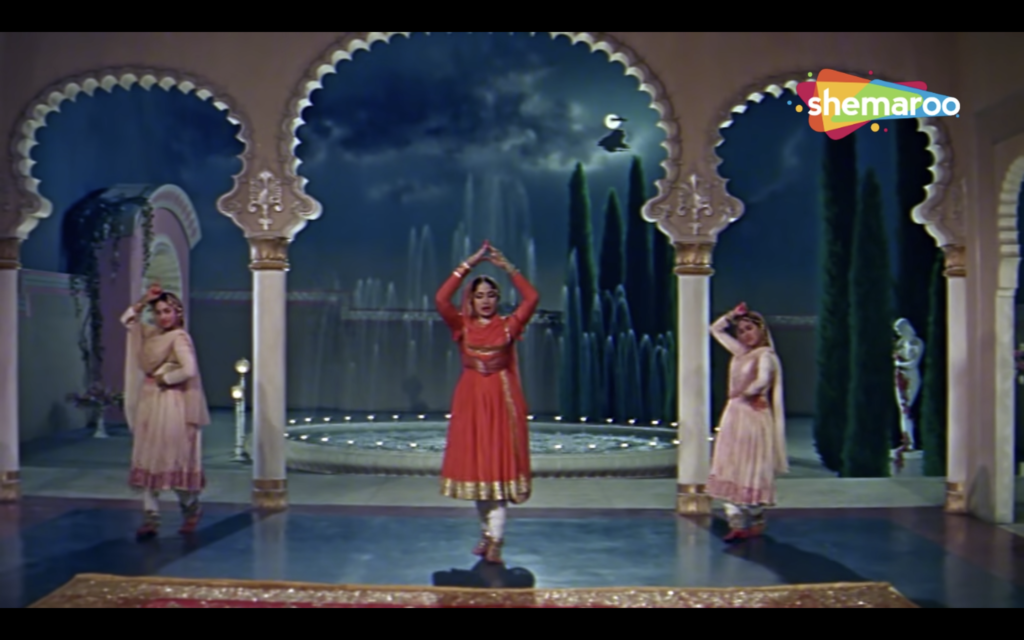
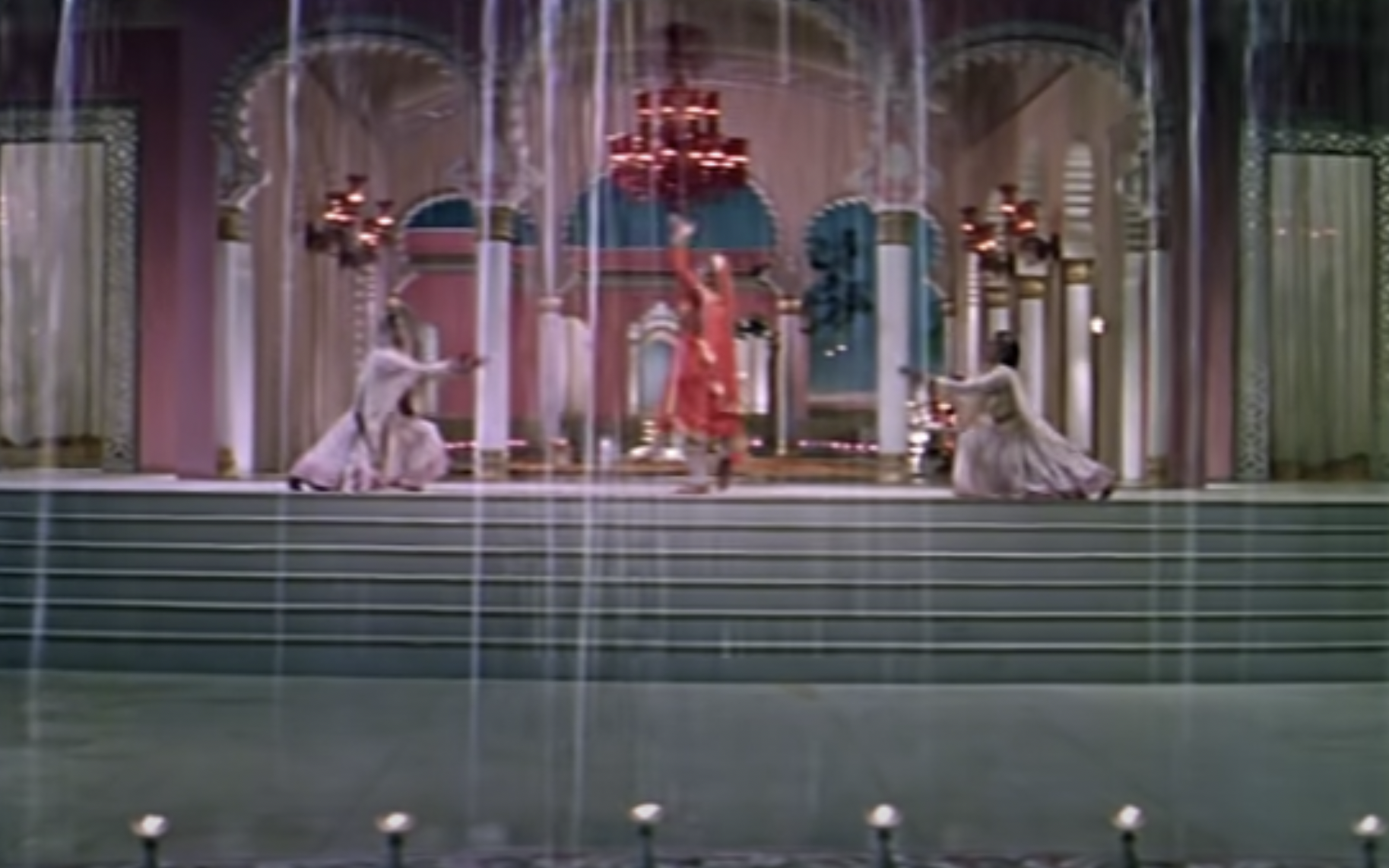
Choreography
As a Kathak dancer growing up practising the dance form, film songs such as this one and from Devdas (2002), Mughal-E-Azam (1960), Umrao Jaan (1981) were considered benchmarks of the delicate, sophisticated grace of Lucknow Gharana of Kathak, embodie from the Mughal period, the long lost ada and etiquettes of Awadh, and the aesthetics of this islamicate inehritance.
Thus, when Mumtaz Mohammed, the song of pakeezah’s music composer ghulam mohammed told me to watch out for the ghoomar elements in Chalte Chalte, I got extremely confused. What was this Rajasthan connection doing in a film that embodied Lucknawi tehzeeb? As you know, Ghulam Mohammed was from Bikaner, Rajasthan, the seat of immesne cultural richness, and i have also spoken about mohammed;s skillful fusion of maand with a banarasi thumri, so of course I had to go down that path, and explore for myself.
After all, the dance in point is kathak/inspired from Kathak, and if I cannot spot elements of Ghoomar in Kathak, it means by undestanding of the roots of kathak movements needs to be deepened, or rather widened. This was not part of my training, this was going against the history of movements we were taught, where movements had names, but rarely were there any elaboration of the desi influences on this.
I took my doubts to Guru Prerana Shrimali, when I went to do my fieldwork in Jaipur, and met at her residence. Being an exponent of the jaipur gharana of kathak, AND. disicple of gauri shanker, the choreographer of the song, and belonging natively to jaipur, as well as being and avid researcher, reader herself, I knew she was just the right person to take my thoughts to.
I am indebted to her for her insights and for introducing this line of thought to me.

She said there are quite a few stances of ghoomar that are seen in kathak. For eg this one :

This style of placing your palm on the shoulder that we see the two dancers in white doing is quite characteristic of ghumar as well as Kathak
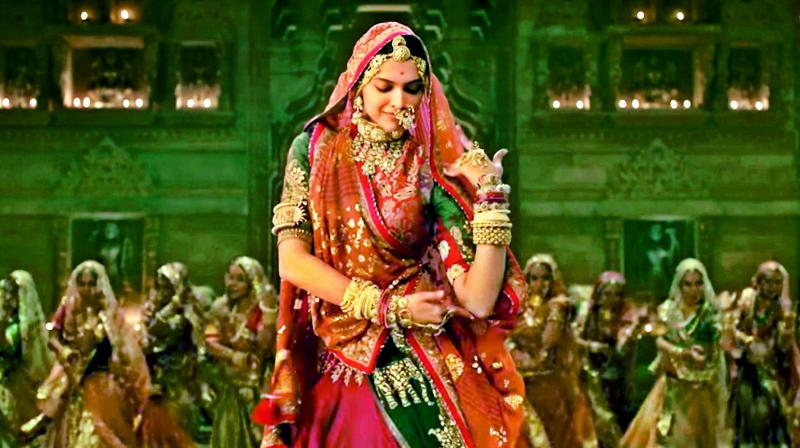
Prerana Shrimali demonstrating the same pose with its variation
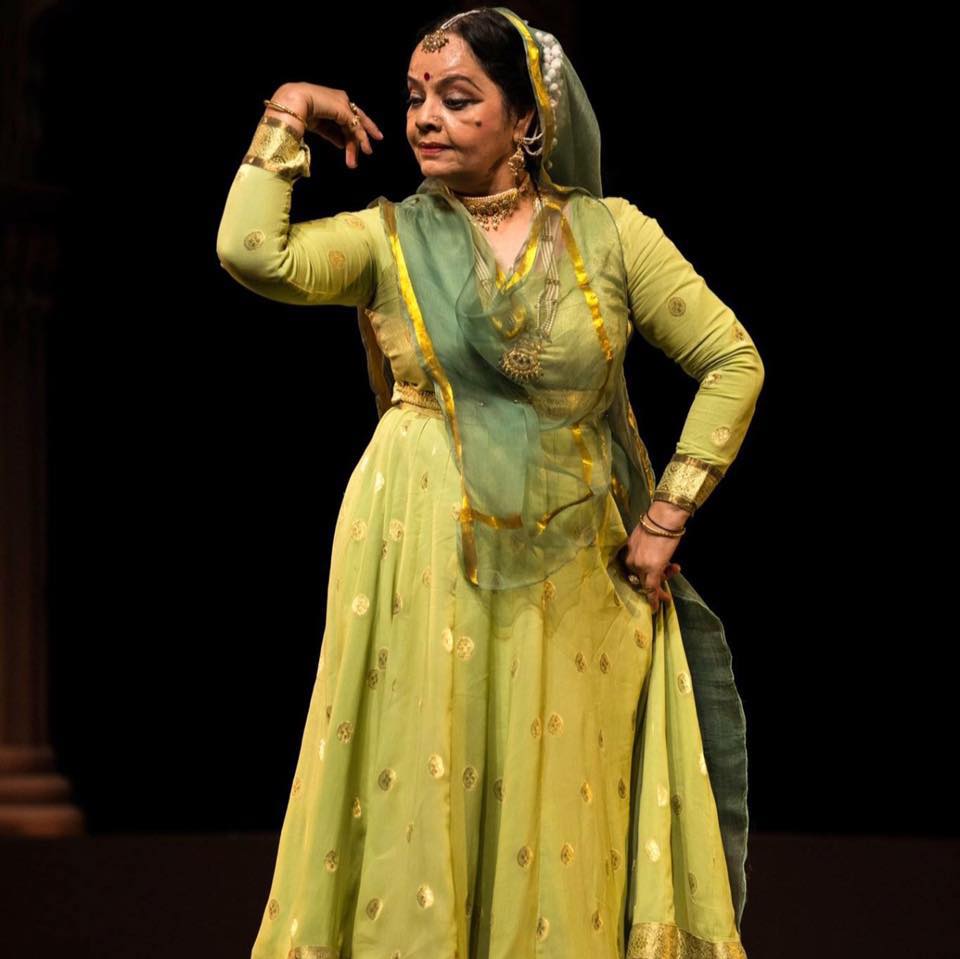
This style of bending knees and taking a turn is very unique to Ghoomar. Whis is but bend hoke oopar aake chakkaer lena us a very arajasthani folk dance thing, which you also see in the song from (duration : which gauri shanker , being a rajasthani as well as kathak dancer, has made use of ). insert image also?
Additionally, she highlighted that the lau shikha movement of kathak is also very similar to ghoomar. But one of the most important inheritance of Rajasthani dances in Kathak is the isolated use of kalai or wrist. The wrist is the key to kathak movements that give it its characteristic flow and crescent shapes. She recalled an incident when she was a student in Kathak Kendra many years ago, and she was doing a rehearsal being conducted by Pt. Birju Maharaj. ‘Maharaj ji’ asked her to play a percussion instrument that required a deft use of the wrist . On seeing her play it rather well, Maharaj ji remarked ‘no wonder your wrists work so well, you are from Rajasthan!’
While none of this can be seen as 100% academic/scholarly evidence, but it taps into a cultural memory and a way of being and doing. It needs a deeper examination in many areas such as study of performing communities, their training, the study of dance forms, their migration, patronage etc. However, it definitely presents as a solid arrow pointing in the direction in which we can progress.
The story of the carpet
In one of my conversations with Mr. Virendra Shankar, son of Pt. Gauri Shanker, the choreographer for this song, he asked me if I noticed the stunning carpet in the song Chalte Chalte. I said of course it fills the screen with gold!
He told me how Kamal Amrohi imported a 50 feet carpet with real zari, specially for the purpose of this song. The carpet is the one that is presented as a gift by the Nawab to Sahibjaan in the film. If one compares the kotha and the floor in the song Thade Rahio which does not have the carpet, and then the song Chalte Chalte Chalte which has the carpet, and how the zari of the carpet, along with other intricate details of the set design and Meena Kumari’s costume transform the screen.
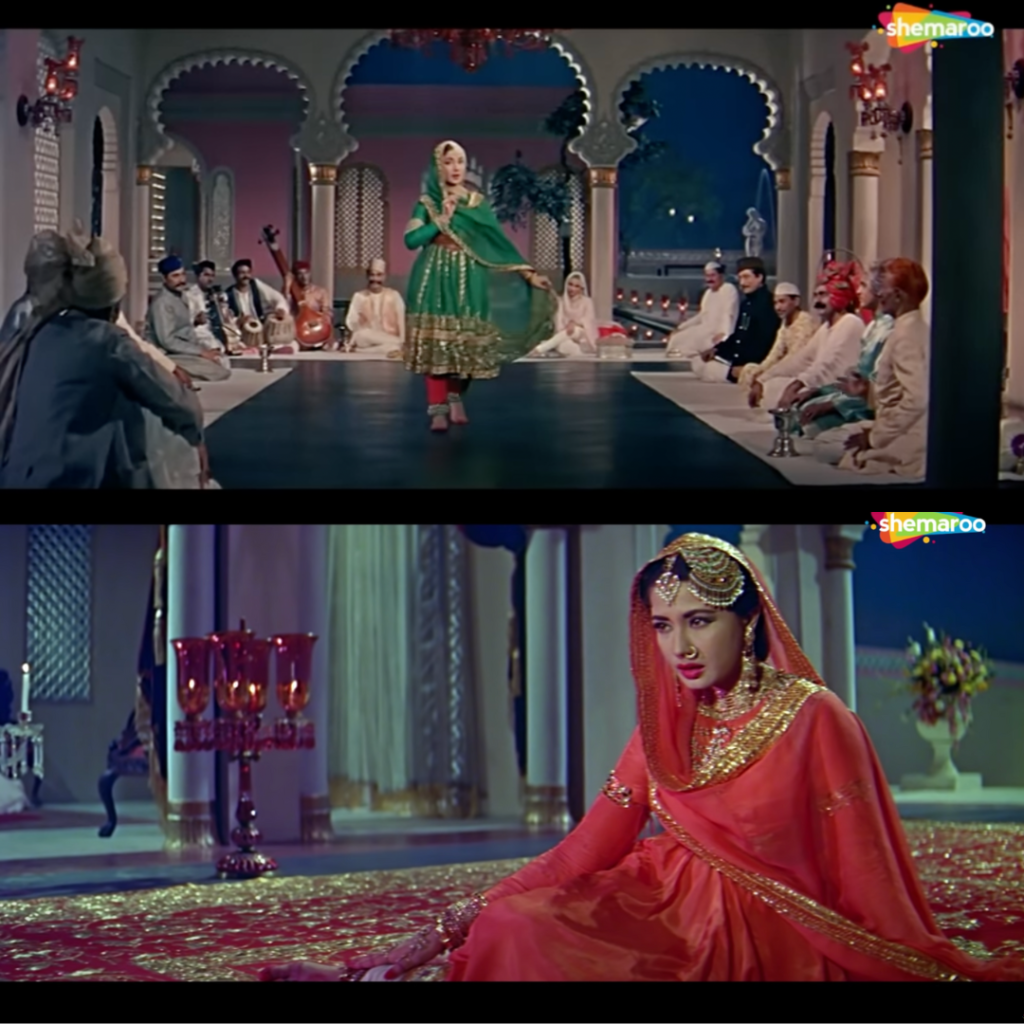
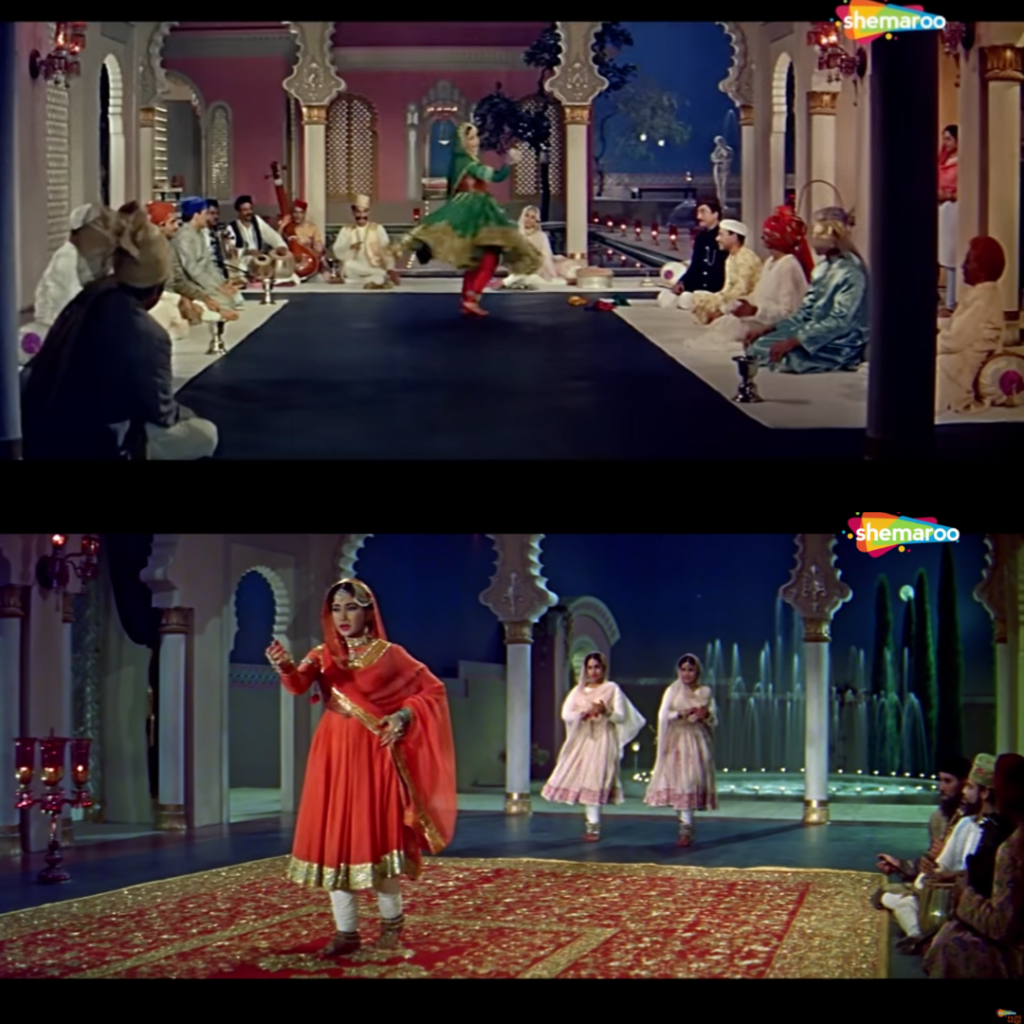
The look
There was this very strange but oddly satisfying blink and miss occurrence in the song. I call it an occurrence very intentionally. I had understood by now that director producer Kamal Amrohi was a perfectionist and would often go on hours, days, weeks, to finalise a single shot. Padma Sharma, a renowned dancer actress as well as Meena Kumari’s body double in the song ‘Teere Nazar’ in Pakeezah, she remarks that if in a day one single shot was taken and OK-ed, it was considered a highly productive day.
Keeping this information in mind, I know that this is not by fluke. Amrohi intended Meena Kumari to look at the camera, DIRECTLY AT US, once- just once in the whole film. and it happens in the song at 3:40. Here :

4. Teer-e-Nazar
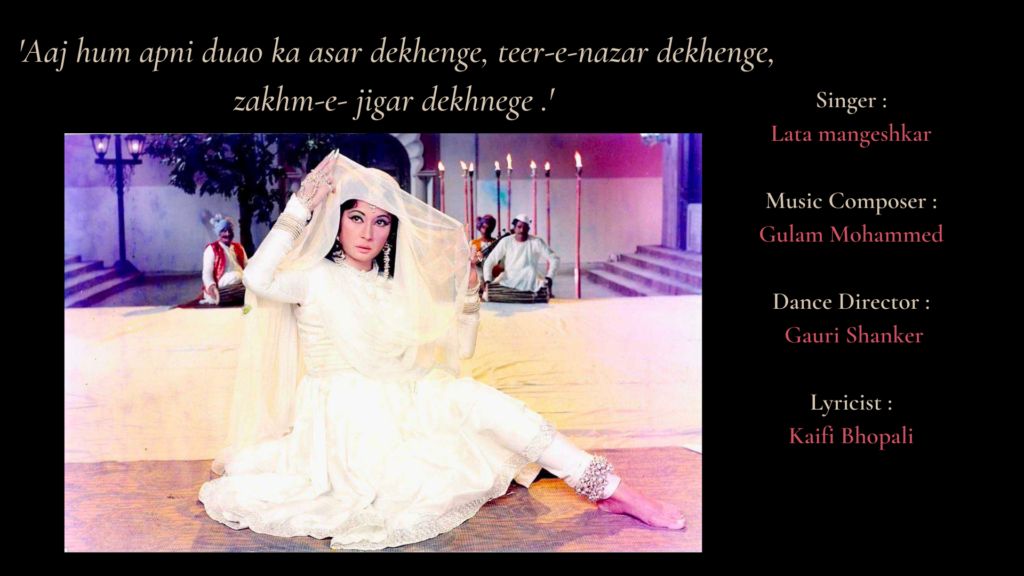
In this highly dramatic song, dancer Actress Padma Sharma was Meena Kumari’s body double in the song. In the end, when Sahibjaan is angry at Salim and she dances on the shards of glass, that is the part played by Padma Khanna.

Belonging to Banaras Gharana, and trained in Banaras as well as by Gopi Kishan in Bombay, she quickly transitioned into a prominent dancer actress in the film industry.

Disclaimer : Unhealthy obsession found
‘Chalte Chalte’ is one of my most favourite songs. The visuals, the set, the minimal but impactful choreography, the longing, the costumes, and the presence of each dancer in the frame has stayed with me since years.
It sounds blasphemous, but instead of Meena Kumari, I was drawn more towards the two dancing girls in white.
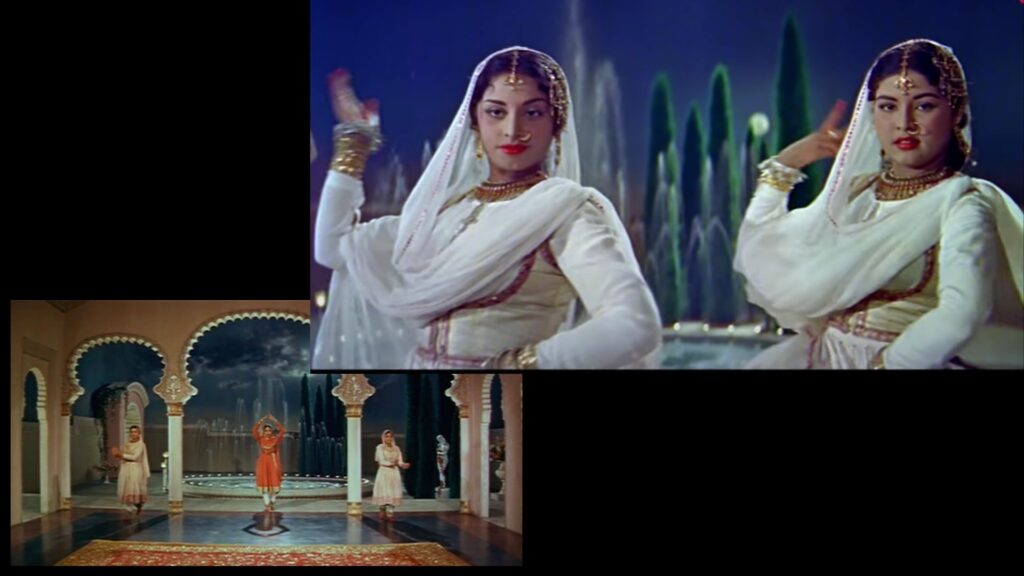
Who were they? It was this rare time when the background dancers looked so prominently in the frame. Their faces were so clear, their expressions and soft presence illuminated the frame, and uplifted the song. Especially since Meena Kumari has very little ‘dance’ in the song, the choreography executed by the two girls really influences our experience of the song. The movements are so in sync with the music, with the repeated use of the word ‘chalte chalte’, the girls perform graceful ‘chaal’/ walks of different kind, coming forward and going back. Hovering gently around Meena Kumari but never overpowering her.
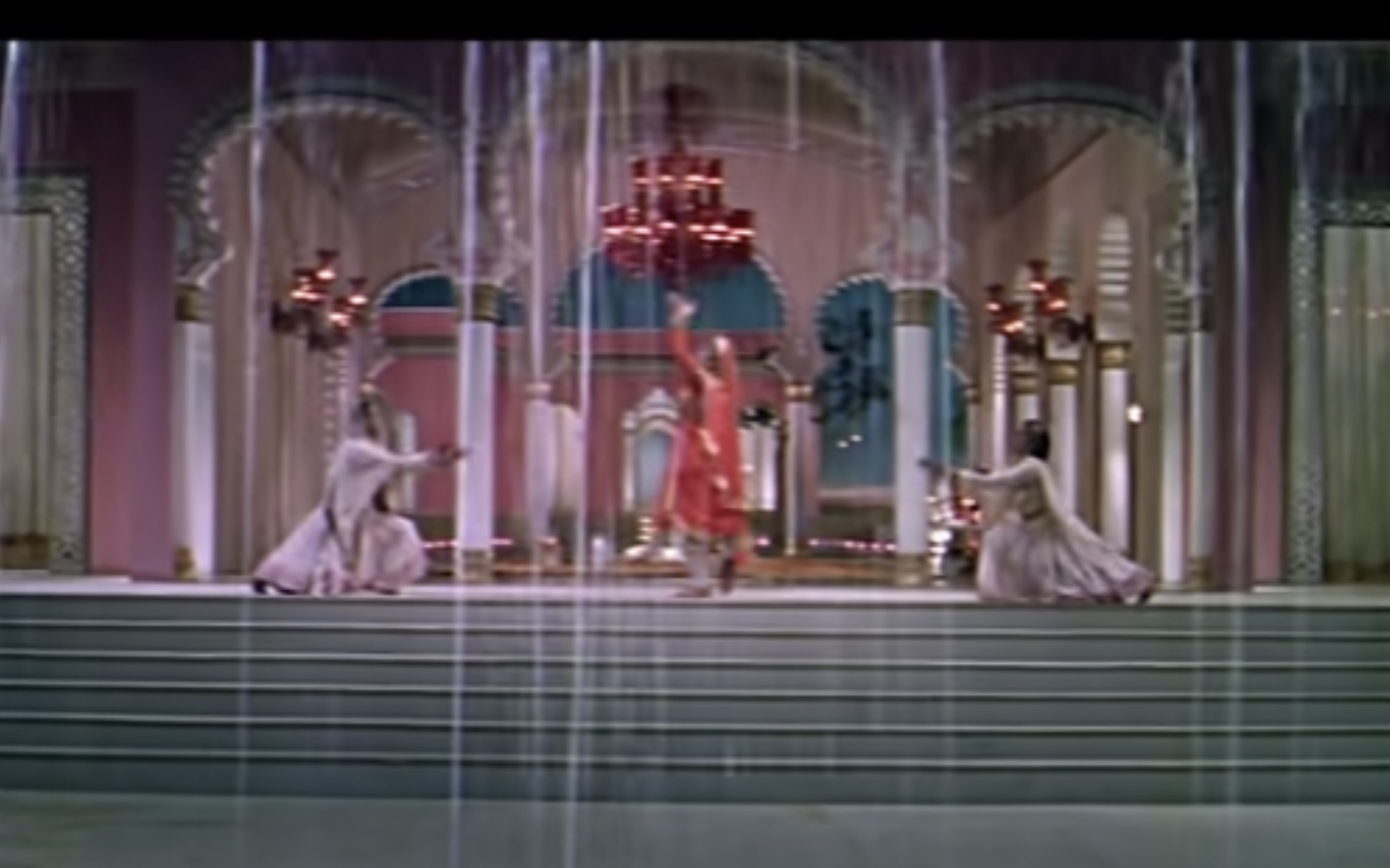
I was determined to find who they were. In the absence of substantial data on films, I resorted to the people who had worked on the film Pakeezah or were in some way associated with it. I spoke to the families of the music composer and dance directors of the film, I spoke with Dancer actress Aanjna MuMTZ WHO AHD SPENT TIME as a child on the sets of pakeezah, i spoke with padma khanna the body double of meena kumari in teere nazar. to everyone, I asled the same question , do you by any chance rememevr the names of thetwo extreas in the song?
Luckuly, people remembered some names. But they couldn’t plave the exact name yto the face. 4 names i heard from everyone, but they couldn’t tell me which was which.

Thus, began my search down the rabbit hole. Armed with 4 names, I began looking for the needle in the haystack.
I went on Imdb, searched for each name one by one, and noted the film credits they were a part of.
For example, for the name Meenaxi (spellings different) it showed the films she was a part of. I went to youtube to check if the movie was avaiolable to watch on the public domain. i watched the credit of the film, as well as went through some scenes of the film to recoignise faces. watched almost every movie

some names, and some faces occured together. and eventually i was able to match the name and aface enough time to make a near accurate guess/
Eventually, I was able to find some commonality. The same face, corresponded with the same name in the credits. My best guess is here :
Meenaxi, is the one on the right, her name comes with various spellings. She was part of aag aur roofaan. devar, and had this dance seuqence qith famous dancer madhumati as well.

The other one was easier to recognise by face but harder to spot by name. Most likely she is Chanda. However, I did get confused with another chanda bai who used to be aan extra in the films from 1930s onwards.
I recognsud tghe face of the other one from the film Sahib bIbi air ghulam,, the lady who plays meena klumari’s chhoti bahu
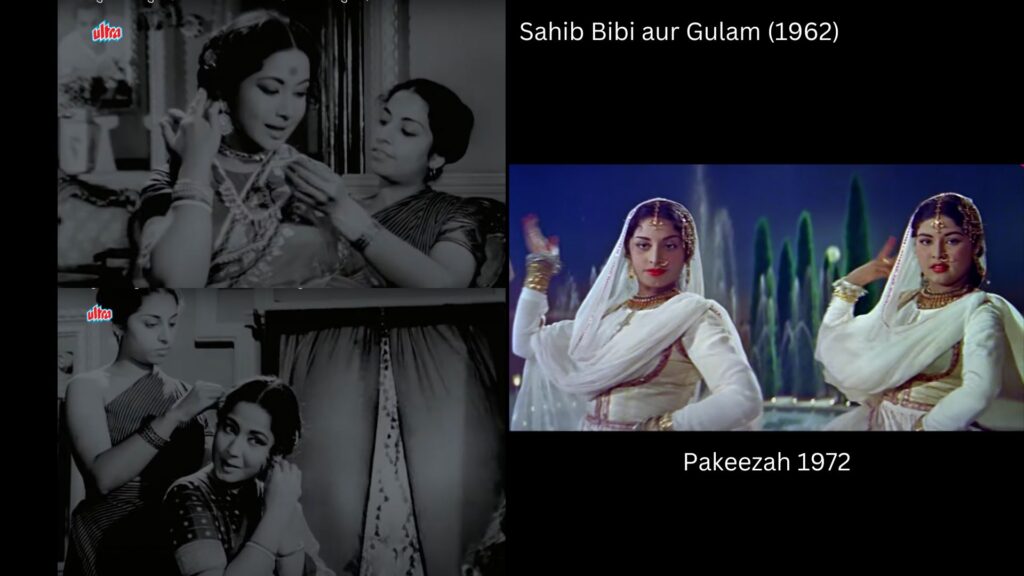
But. Whats in a name?
At the end of the day, I knew these were not their real names. I know,such a long description only to share that thgese are just their screen names. Anjana Mumtaz sjared tghat thy were musim women who had come to bombay , from uP for work, and as it was common for many (Not all) women at that time to change their name and assume a screen presence. they change dtgheir names.
so much hgides behind a name, and so much is revealed, even in the act of not revealing. abo
Indebted to the following for guiding me and showing me paths to explore in my research process :
- India Foundation for the Arts, Bangalore
- Interview with Mumtaz Mohammed and Yusuf Mohammed : sons of music director Late Ghulam Mohammed
- Interview with Virendra Shankar and Bhima Shankar : Grandson and Son respectively of choreographer Lt Pt. Gauri Shanker
- Pt. Rajendra Gangani, Kathak Guru
- Padma Khanna, Dancer Actress
- Anjana Mumtaz, Dancer Actress
- Professor Kaushik Bhaumik, JNU
- Professor Ira Bhaskar, JNU
Artistry v/s Artisanal
When I was talking to Mumtaz Mohammed, the elder son of Ghulam Mohammed, he said this word which struck me. He said ‘pakeezah banane wale log karigar log the’ – The people who made Pakeezah were artisans.
His choice to describe this art as as kind of craftsmanship, as opposed to just calling them great artists, stayed with me. Indeed, there is an artisanal quality, a way of doing things with your hands, with your fingers, with care, like building a monument, a miniature painting, where every detail is intricate and exquisite, not just the material part of it, but its song and dance too.
Some of the musicians who played in the film + trivia on the film’s music :


I found this beautiful video of a young Rais Khan, playing Pakeezah’s background music score in a BBC Studio Recording . The signature tune starts at 0:49
Speaking of background score, much has been said about the aural atmosphere of the film. In order to give a sense of the bazar and the multiple kothas that inhabit it, in many scenes there is an almost continuous soft background sound of thumris being sung in the near distance, that make the viewer feel they have travelled ‘inside’ a world. Many of the thumris are now lost, however some have been recorded and preserved.
In addition to this, there are a host of songs that were composed by music composer Ghulam Mohammed, that though did not make it in the film, were released as part of the album called ‘Pakeezah Rang Barang’. Though there over a dozen songs, two of my favourites are 1)Leke Angrai, which begins with a verse in Meena Kumari’s voice, and 2) Bandhan Baandho by Shobha Gurt
